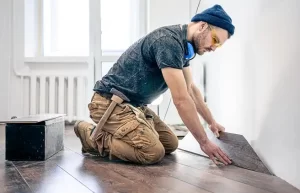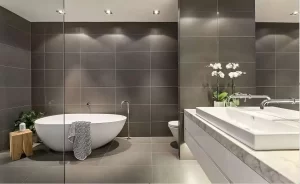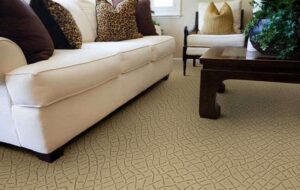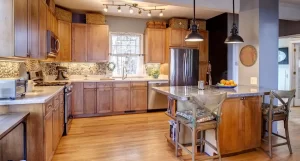Table of Contents
1. Introduction
Selecting the perfect hardwood flooring for your space is a significant decision that can transform the look and feel of your home.
This comprehensive guide will walk you through the essential steps and considerations to ensure you make an informed choice that aligns with your style, budget, and lifestyle. From budgeting and hardwood types to maintenance and environmental concerns, we’ve got you covered. Let’s dive in!
1.1 The Importance of Choosing the Right Hardwood Flooring
Hardwood flooring is more than just a functional element of your home; it’s a design choice that can significantly impact your space’s overall aesthetics and atmosphere. The warmth, durability, and timeless beauty of hardwood make it a popular choice for homeowners looking to add value and elegance to their properties.
However, selecting the perfect hardwood flooring is not a one-size-fits-all endeavour. It requires careful consideration of various factors to ensure your choice aligns with your needs and preferences.
1.2 Factors to Consider Before Making Your Decision
Before diving into the specifics of hardwood species, finishes, and installation methods, it’s crucial to assess your unique circumstances and preferences. Here are some essential factors to consider:
1.2.1 Room Usage
Think about how the room will be used. Is it a high-traffic area like the living room or a low-traffic space like a bedroom? Different areas may require different hardwood types.
1.2.2 Climate and Environment
The climate and humidity levels in your region can affect the performance of hardwood floors. Some woods are more resistant to moisture than others.
1.2.3 Design Style
Your interior design style plays a vital role in choosing the right hardwood. Are you going for a traditional, rustic, modern, or eclectic look? Each style may be complemented by specific wood species and finishes.
1.2.4 Budget
Determine your budget for hardwood flooring and consider not just the initial cost but also long-term maintenance expenses.
1.2.5 Sustainability
If you’re environmentally conscious, explore sustainable and eco-friendly hardwood options to minimize your impact on the environment.
1.2.6 Installation Preferences
Decide whether you want to undertake a DIY installation or hire professionals. This choice may influence the type of hardwood and installation method you choose.
2. Setting Your Budget
2.1 Establishing Your Flooring Budget
Your budget is the foundation of your hardwood flooring decision. Consider both the cost of materials and installation. While hardwood flooring is an investment in your home’s value and aesthetic appeal, it’s essential to set a budget that you’re comfortable with.
Begin by researching the average cost of hardwood flooring in your area and assessing your financial situation. Keep in mind that factors such as the size of the space, the type of wood, and any additional features (like custom finishes) will affect the final price.
2.2 Understanding Cost Factors
Several factors influence the cost of hardwood flooring:
2.2.1 Wood Species
The type of wood you choose significantly impacts the price. Exotic and rare woods tend to be more expensive than domestic species like oak or maple.
2.2.2 Hardwood Type
Solid hardwood is generally more expensive than engineered hardwood due to its thickness and solid wood composition.
2.2.3 Grade and Quality
Higher-grade wood with fewer imperfections comes at a premium cost. Selecting a lower-grade wood may reduce expenses.
2.2.4 Finish and Texture
The finish and texture you desire can influence the price. Hand-scraped or distressed finishes, for example, often cost more than smooth finishes.
2.2.5 Installation Costs
Hiring professionals for installation will add to your expenses, but it ensures a quality installation that maximizes the lifespan of your floors.
2.2.6 Additional Features
Special features like custom stains, inlays, or intricate patterns will raise the cost of your hardwood flooring project. By understanding these cost factors and establishing a clear budget, you’ll be better prepared to make informed decisions about the type of hardwood flooring that suits your space and finances.
3. Types of Hardwood Flooring
3.1 Solid Hardwood vs. Engineered Hardwood
When it comes to selecting hardwood flooring, you’ll often have two primary options: solid hardwood and engineered hardwood. Understanding the differences between them is essential for making the right choice.
3.1.1 Solid Hardwood
This type of flooring is crafted from a single piece of wood, typically 3/4-inch thick. It’s renowned for its durability and timeless beauty.
Solid hardwood can be sanded and refinished multiple times, which makes it a long-lasting investment for your home. However, it is more susceptible to moisture-related issues, so it’s best suited for above-grade spaces.
3.1.2 Engineered Hardwood
Engineered hardwood is constructed with a thin layer of real wood veneer on top of multiple layers of plywood or high-density fiberboard (HDF). This layered structure makes it more stable and less prone to warping or cupping due to changes in humidity.
Engineered hardwood is an excellent choice for areas with varying moisture levels, such as basements or regions with high humidity. It’s also available in a wide range of wood species and finishes, offering versatility in design.
3.2 Pros and Cons of Each Type
To help you make an informed decision, here are the key advantages and disadvantages of both solid and engineered hardwood flooring:
3.2.1 Solid Hardwood
Pros
- Authentic and timeless look.
- Can be sanded and refinished multiple times, extending its lifespan.
- Adds significant value to your home.
Cons
- Susceptible to moisture, making it unsuitable for below-grade spaces.
- Prone to expansion and contraction with temperature and humidity changes.
- Generally more expensive than engineered hardwood.
3.2.2 Engineered Hardwood:
Pros
- More stable and less prone to moisture-related issues.
- Suitable for a broader range of environments, including basements.
- Available in various wood species, finishes, and textures.
Cons
- Limited number of times it can be refinished (the top veneer layer).
- The appearance may not be as authentic as solid hardwood.
- Quality can vary depending on the manufacturer and product.
Note: Your choice between solid and engineered hardwood will depend on your specific needs, including the environment in which the flooring will be installed and your design preferences. The interesting fact is that both options offer unique benefits, so consider which factors matter most to you when making your selection.
Next, we will delve into additional factors that will influence your choice, such as assessing your lifestyle and traffic levels, exploring different wood species, and selecting the right finish and texture for your hardwood flooring.
4. Assessing Your Lifestyle and Traffic Levels
4.1 Identifying High-Traffic Areas
Before choosing the perfect hardwood flooring for your space, it’s crucial to evaluate the level of foot traffic each area receives. High-traffic areas, such as hallways, living rooms, and kitchens, require more durable hardwood to withstand the wear and tear.
4.1.1 Hallways
These areas often see constant traffic and may be exposed to dirt and grit from the outdoors. Choose hardwood with a high level of durability, like oak or hickory, for hallways.
4.1.2 Living Rooms
Living rooms are central gathering spaces and should feature hardwood that can handle frequent use. Durable options like oak or maple are excellent choices.
4.1.3 Kitchens
Kitchens are prone to spills and moisture, so it’s essential to select hardwood that is more resistant to water damage. Engineered hardwood can be a suitable option for kitchen spaces.
4.2 Choosing Hardwood Hardness Levels
The hardness of hardwood species is measured on the Janka hardness scale. A higher Janka rating indicates greater hardness and durability. Here are some common hardwood species and their Janka ratings:
4.2.1 Oak
Oak is a popular choice with a Janka rating of around 1290. It’s known for its durability and versatility, making it suitable for various spaces.
4.2.2 Hickory
Hickory is one of the hardest domestic woods, with a Janka rating ranging from 1820 to 2250. It’s an excellent choice for high-traffic areas.
4.2.3 Maple
Maple has a Janka rating of approximately 1450, offering moderate durability and a light, uniform appearance.
4.2.4 Cherry
Cherry wood is softer, with a Janka rating of about 950. While it’s less durable, its rich, reddish-brown color adds elegance to spaces with lower foot traffic.
4.2.5 Walnut
Walnut has a Janka rating of around 1010 to 1090, making it suitable for spaces where durability is less of a concern than aesthetics. Select hardwood with a Janka rating that aligns with the traffic levels in your space. For high-traffic areas, prioritize durability and hardness, while for lower-traffic spaces, you can focus more on the wood’s appearance and character.
5. Exploring Wood Species
5.1 Popular Wood Species for Hardwood Flooring
Hardwood flooring offers a wide range of wood species to choose from, each with its unique grain patterns, colors, and characters. Here are some popular wood species for hardwood flooring:
5.1.1. Oak
Oak is a timeless favorite known for its strength and versatility. It comes in both red and white varieties, with distinct grain patterns.
5.1.2 Maple
Maple offers a light, uniform appearance and is an excellent choice for contemporary and minimalist spaces.
5.1.3 Cherry
Cherry wood features a rich, reddish-brown color that darkens over time, lending elegance and sophistication to your room.
5.1.4 Walnut
Walnut boasts a deep, chocolate-brown color and a luxurious, intricate grain pattern, making it ideal for formal spaces.
5.1.5 Hickory
Hickory is extremely durable and has a rustic, natural look that works well in country or farmhouse-style homes.
5.2 How Wood Species Affects Aesthetics
The choice of wood species significantly influences the appearance of your hardwood flooring. The color, grain pattern, and character of the wood can complement or contrast with your overall interior design. Consider the following:
5.2.1 Color
Different wood species come in various natural colors, from the light tones of maple to the dark hues of walnut. Choose a color that harmonizes with your room’s color scheme and decor.
5.2.2 Grain Pattern
The grain pattern of the wood, whether it’s pronounced or subtle, can add depth and character to your space. Oak, for instance, has a prominent grain, while maple has a more uniform appearance.
5.2.3 Character
Some wood species may exhibit natural features like knots, mineral streaks, or burls, adding unique personality to your hardwood floors. If you prefer a clean and modern look, you might opt for wood with fewer imperfections.
Read more “Celebrating Style and Comfort: Exploring the Latest Trends in Interior Design“
Ultimately, your choice of wood species should align with your design preferences and the ambiance you want to create in your space. Keep in mind that different species also have varying levels of hardness and durability, so consider both aesthetics and practicality when making your selection.
6. Selecting the Right Finish and Texture
6.1 The Impact of Finish on Appearance
The finish of your hardwood flooring is the topcoat that provides protection, enhances the wood’s natural beauty, and contributes to the overall aesthetic. There are various finish options to choose from, each with its unique characteristics:
6.1.1 Matte Finish
A matte finish provides a subtle, natural appearance with minimal sheen. It’s an excellent choice for creating a contemporary or rustic look and is less prone to showing scratches and imperfections.
6.1.2 Satin Finish
Satin finishes offer a slightly higher level of sheen than matte finishes but are still relatively low in gloss. They strike a balance between a natural look and the ability to hide wear and tear.
6.1.3 High-Gloss Finish
High-gloss finishes provide a shiny, reflective surface that can add a touch of luxury and formality to your space. However, they are more prone to showing scratches and imperfections.
The choice of finish depends on your design style and how you want your space to feel. While matte and satin finishes are more popular for contemporary and casual spaces, high-gloss finishes can work well in formal and elegant settings.
6.2 Texture Options and Their Effects
The texture of your hardwood flooring can significantly impact the overall character of your space. Different textures can enhance the wood’s natural grain, add depth, and create visual interest. Here are some common texture options:
6.2.1 Smooth Finish
Smooth hardwood flooring offers a clean and polished appearance. It’s a timeless choice that works well in traditional and modern settings.
6.2.2 Hand-Scraped Finish
Hand-scraped flooring features intentional, subtle grooves and scrapes that give it a rustic, aged look. It’s ideal for creating a warm and inviting ambiance.
6.2.3 Wire-Brushed Finish
Wire-brushed textures add depth to the wood by removing the softer grain and leaving the harder grain exposed. This technique creates a tactile, textured surface that can be both rustic and contemporary.
6.2.4 Distressed Finish
Distressed hardwood flooring replicates the look of reclaimed wood with various imperfections, such as dents, dings, and knots. It’s perfect for achieving a vintage or weathered appearance.
When selecting the right texture and finish for your hardwood flooring, consider the overall style of your space and how you want it to feel. Smooth finishes offer a clean and classic look, while textured options can add warmth, character, and a touch of uniqueness to your room.
7. Maintenance Considerations
7.1 Understanding Maintenance Needs
Proper maintenance is essential to preserve the beauty and longevity of your hardwood flooring. Different hardwood species and finishes have varying maintenance requirements. Here are some general maintenance considerations:
7.1.1 Regular Cleaning
Sweep or vacuum your hardwood floors regularly to remove dirt and debris that can scratch the surface. Use a damp mop with a recommended hardwood floor cleaner for deeper cleaning.
7.1.2 Avoid Moisture
Hardwood is sensitive to moisture, so clean up spills promptly, and use mats in high-moisture areas like entryways and kitchens.
7.1.3 Periodic Refinishing
Solid hardwood can be sanded and refinished multiple times to remove scratches and refresh the finish. The frequency of refinishing depends on the wear and tear your floors endure.
7.1.4 Furniture Pads
Place furniture pads under heavy furniture to prevent scratches and indentations.
7.1.5 Area Rugs
Use area rugs in high-traffic areas to protect the wood and add warmth and style to your space.
7.2 Tips for Keeping Your Hardwood Floors Looking Great
To ensure your hardwood floors remain in top condition, consider these maintenance tips:
- Follow the manufacturer's care and maintenance guidelines for your specific hardwood flooring.
- Place doormats at entryways to trap dirt and prevent it from being tracked onto the hardwood.
- Use furniture glides or felt pads under furniture legs to prevent scratches when moving furniture.
- Keep humidity levels within a recommended range to prevent excessive expansion or contraction of the wood.
- Avoid wearing high heels or shoes with abrasive soles on hardwood floors.
Regular care and maintenance will not only preserve the beauty of your hardwood flooring but also extend its lifespan, ensuring that your investment continues to enhance your space for years to come.
8. Environmental and Sustainability Factors
8.1 Eco-Friendly Flooring Options
If you’re environmentally conscious, you can make eco-friendly choices when selecting hardwood flooring. Sustainable options help reduce the impact on forests and promote responsible sourcing. Here are some eco-friendly options to consider:
8.1.1 FSC-Certified Wood
The Forest Stewardship Council (FSC) certification ensures that the wood comes from responsibly managed forests. Look for FSC-certified hardwood flooring to support sustainable practices.
8.1.2 Reclaimed Wood
Reclaimed hardwood flooring is sourced from older structures like barns, factories, or warehouses. It not only gives new life to old wood but also reduces the demand for newly harvested timber.
8.1.3 Bamboo
While technically a grass, bamboo is a popular eco-friendly flooring choice due to its rapid growth and renewability. It’s available in various styles and colors.
8.1.4 Cork
Cork flooring is made from the bark of cork oak trees, which regenerate after harvesting. It’s a renewable and biodegradable material that’s soft underfoot and provides natural insulation.
8.1.5 Engineered Hardwood
Some engineered hardwood options use sustainable materials in their construction, making them an eco-conscious choice.
8.2 Certifications to Look for
When choosing eco-friendly hardwood flooring, keep an eye out for certifications that ensure sustainable practices. In addition to FSC, other certifications like the Sustainable Forestry Initiative (SFI) and the Programme for the Endorsement of Forest Certification (PEFC) also indicate responsible sourcing and environmentally friendly practices.
Making a sustainable choice not only benefits the environment but also supports ethical and responsible forestry practices.
9. Installation Methods and Professional Help
9.1 DIY vs. Professional Installation
The installation of hardwood flooring is a critical step that can significantly affect the durability and appearance of your floors. When deciding whether to go the DIY route or hire professionals, consider the following:
9.1.1 DIY Installation
If you have experience with flooring installation and the necessary tools, you may choose to install hardwood flooring yourself. However, keep in mind that improper installation can lead to issues like gaps, uneven surfaces, and premature wear.
9.1.2 Professional Installation
Hiring experienced flooring professionals ensures a precise and well-executed installation. Professionals have the knowledge and expertise to handle challenges like uneven subfloors, transitions between rooms, and proper acclimation of the wood.
9.2 Preparing Your Subfloor
Proper preparation of the subfloor is crucial for a successful hardwood flooring installation. Before installation, ensure that your subfloor is clean, level, dry, and free of any structural issues. This preparation includes:
- Removing existing flooring materials, such as carpet, tile, or laminate.
- Repairing any subfloor damage, such as cracks or squeaks.
- Installing a moisture barrier if necessary, especially in areas prone to moisture.
- Acclimating the hardwood to the environment to prevent expansion or contraction after installation.
- Checking for levelness to prevent uneven flooring.
Hiring professionals for installation or seeking expert advice on DIY installation techniques can save you time, effort, and potential headaches down the road.
10. Finalizing Your Decision
10.1 Gathering Quotes and Estimates
Before finalizing your decision, obtain quotes and estimates from multiple sources, whether you plan to hire professionals or purchase materials for a DIY project.
These quotes should include the cost of materials, installation (if applicable), and any additional expenses like underlayment, subfloor repairs, or moisture barriers.
10.2 Making Your Selection with Confidence
Armed with the knowledge gained from this guide and the quotes you’ve collected, you can now make your hardwood flooring selection with confidence. Ensure that your choice aligns with your budget, lifestyle, design preferences, and environmental values.
Remember that hardwood flooring is an investment in the beauty and value of your home. With thoughtful consideration and attention to detail, you’ll select the perfect hardwood flooring that enhances your space and provides years of enjoyment.
In conclusion, the journey to selecting the perfect hardwood flooring for your space involves a series of well-informed decisions. From assessing your lifestyle and traffic levels to considering eco-friendly options and installation methods, each step plays a crucial role in creating the ideal hardwood floor that complements your home and personal style.
11. Frequently Asked Questions (FAQs)
Certainly! Here are some frequently asked questions (FAQs) related to selecting the perfect hardwood flooring for your space:
- Hardwood flooring offers timeless beauty and durability.
- It increases the value of your home.
- It’s easy to clean and maintain.
- Hardwood floors can be refinished to look like new.
- They provide a warm and inviting atmosphere to your space.
- Determine the size of the area you plan to cover.
- Research the cost of hardwood materials and installation in your region.
- Consider any additional expenses such as underlayment or subfloor repairs.
- Factor in your personal budget and financial situation.
- Solid hardwood is made from a single piece of wood and is thicker, offering the ability to be sanded and refinished multiple times.
- Engineered hardwood consists of a thin veneer of real wood on top of multiple layers of plywood or HDF, providing greater resistance to moisture and temperature fluctuations.
- Consider your design style and color preferences.
- Assess the level of durability required based on the room’s traffic.
- Determine whether you prefer a pronounced grain pattern or a more uniform appearance.
- Take into account the hardness of the wood species, measured by the Janka hardness scale.
- The finish should align with your design style and desired level of sheen (matte, satin, or high gloss).
- Texture options include smooth, hand-scraped, wire-brushed, and distressed, each offering a different look and feel.
- The choice of finish and texture depends on your room’s style and ambiance.
- Regularly sweep or vacuum to remove dirt and debris.
- Clean up spills promptly to prevent water damage.
- Consider using area rugs and furniture pads to protect the wood.
- Follow manufacturer-recommended cleaning products and techniques.
- Schedule periodic refinishing to remove scratches and renew the finish.
- Look for FSC-certified wood, which comes from responsibly managed forests.
- Consider reclaimed wood sourced from older structures.
- Bamboo and cork are renewable and eco-friendly flooring options.
- Some engineered hardwood products use sustainable materials in their construction.
- While DIY installation is an option, it requires experience and the right tools.
- Professional installation ensures precision and can prevent future problems.
- The choice between DIY and professional installation depends on your skill level and the complexity of the project.
- Remove existing flooring materials and ensure a clean surface.
- Repair any subfloor damage, such as cracks or squeaks.
- Install a moisture barrier if needed, especially in moisture-prone areas.
- Acclimate the hardwood to the environment to prevent expansion or contraction.
- Check for levelness to ensure even flooring.
- Gather quotes and estimates from multiple sources.
- Consider all factors, including budget, lifestyle, design preferences, and environmental values.
- Review the information you’ve collected from this guide.
- Make your selection with confidence, knowing that your choice aligns with your unique needs and style.
These FAQs provide answers to common questions about choosing hardwood flooring, but don’t hesitate to consult with flooring professionals or experts for personalized advice based on your specific circumstances.
12. Addition Resources - Related Articles
Here are some related blog posts on hardwood flooring that you may find helpful:
- Hardwood Flooring vs. Laminate: Which is Right for You?" This blog post compares the pros and cons of hardwood flooring and laminate flooring, helping you decide which is the best fit for your home.
- "The Complete Guide to Hardwood Floor Maintenance: Discover essential tips and tricks to keep your hardwood floors looking their best for years to come.
- Choosing the Perfect Wood Stain for Your Hardwood Floors: Learn about different wood stains and finishes to customize the appearance of your hardwood floors to match your interior design.
- How to Install Hardwood Floors: DIY vs. Professional Installation". This blog post delves into the factors to consider when deciding whether to install hardwood floors yourself or hire professionals.
- Mastering Home, Kitchen, and Bathroom Flooring: Your Comprehensive Guide to Elevating Your Space". Explore various eco-friendly flooring options, including sustainable hardwood choices, to reduce your environmental footprint.
- The Ultimate Guide to Choosing the Perfect Flooring for Your Home: Discover the unique charm and environmental benefits of using reclaimed wood for your flooring projects.
- A Comprehensive Guide to Bathroom and Kitchen Flooring: Materials and Contractors: Stay up-to-date with the latest trends in bathroom and kitchen flooring, including popular flooring materials, finishes, and design styles.
Feel free to click on the links to read more about each topic and expand your knowledge of hardwood flooring and related subjects.








